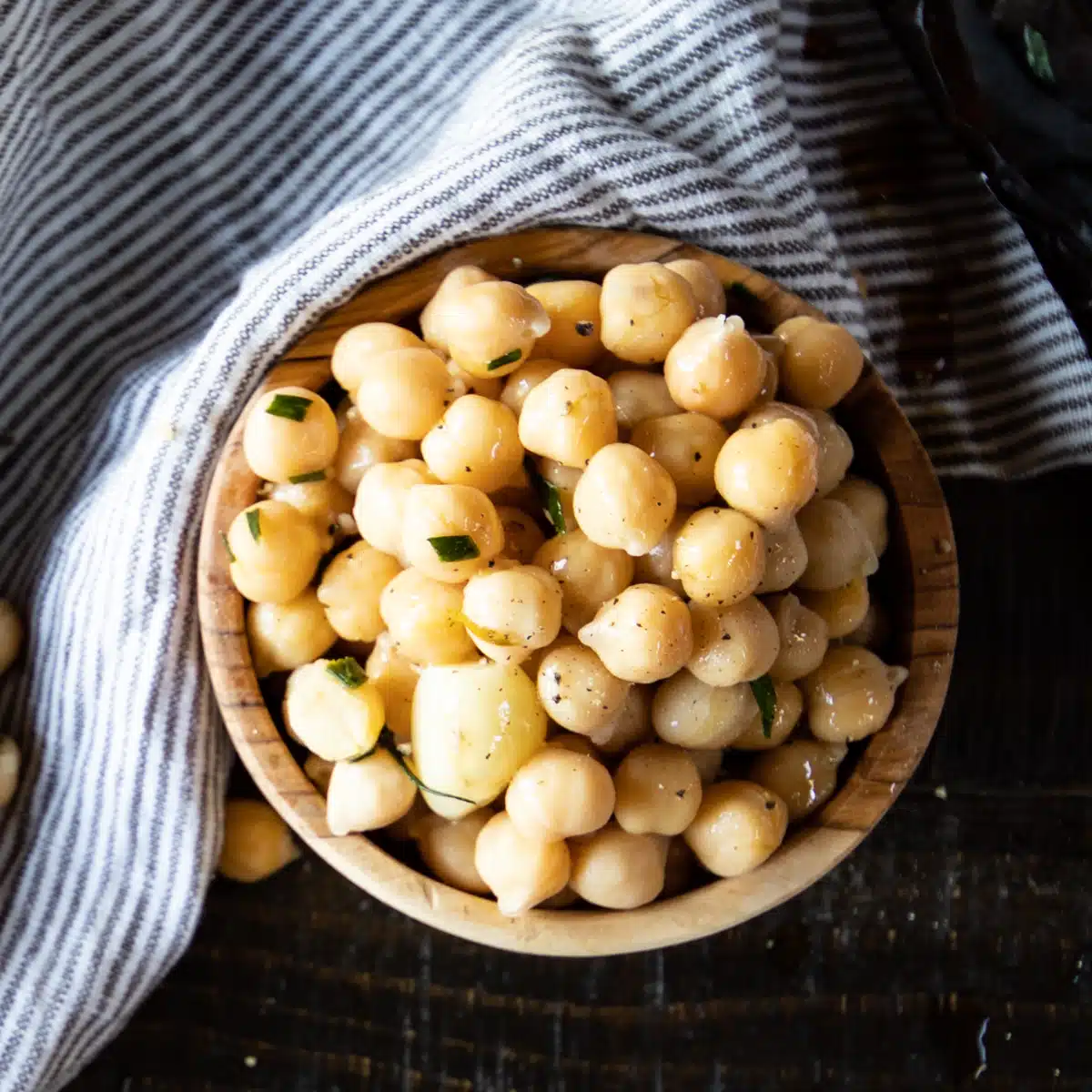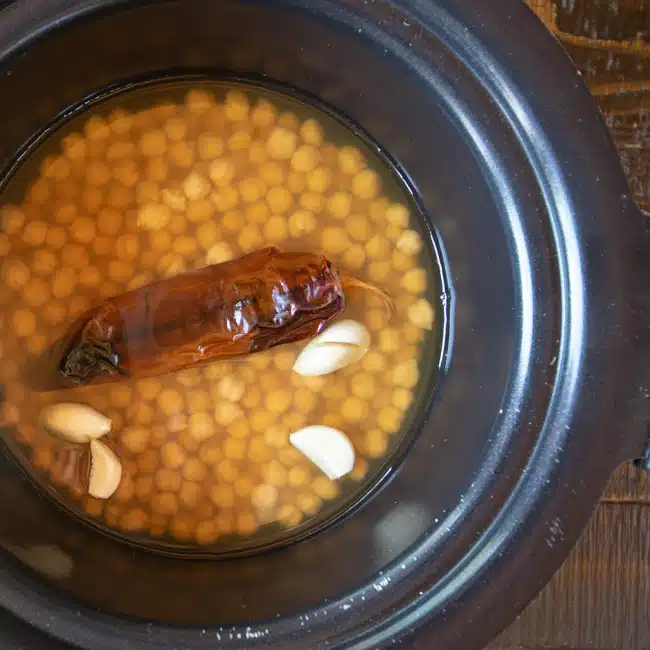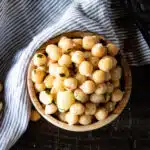Instructions on how to cook chickpeas in the slow cooker, or crock pot, and tips on adding salt and whether you need to pre-soak the beans.
Slow cooker chickpeas are soooo easy. This way of cooking them allows you to pile the chickpeas in the slow cooker or crockpot along with water or broth, cover, and walk away for a few hours.
Jump to Recipe
Want to make this recipe perfectly the first time? I want to help with that. So, check out this Table of Contents to see which sections of this post will help you the most.
Jump to:
- 📝 Ways to Cook Chickpeas (Garbanzo Beans)
- 🎉 Advantages to Slow Cooker Method
- 🤷♀️ Why Won't My Dried Beans Soften?
- 🛁 Should I pre-soak the beans?
- ⏰ How Long to Cook Chickpeas in the Slow Cooker
- 📌 Important Note:
- 🫙 How to Store Chickpeas
- 📇 Recipes for Cooked Chickpeas
- How to Cook Chickpeas in the Slow Cooker or Crockpot
A stash of cooked chickpeas in the refrigerator or freezer means easy, last-minute dinners are only a few minutes away. And cooking them in the slow cooker or crock pot, is incredibly easy to do.
While they slowly cook at home, go to work, pick up the kids from school, or go skiing for the day. Then add them to tacos with pickled onions, sliced tomatoes, and avocado. Or toss them into a chickpea spaghetti dish.
📝 Ways to Cook Chickpeas (Garbanzo Beans)
The biggest difference between the various methods for cooking chickpeas is the amount of time it takes.
#1. Slow Cooker or Crock Pot
- Cooking chickpeas in the slow cooker isn't the fastest way to cook dried chickpeas, but it may be the easiest.
#2. Stovetop Chickpeas (or in the oven)
- Check out this post on How to Cook Dried Chickpeas on the Stovetop. The article includes tips for getting the best texture, and what to do when your beans won't soften.
#3. Electric Pressure Cooker
- Here's a post for How to Cook Black Beans in the Instant Pot, which can be easily modified for chickpeas.
- Cook time: 35 minutes for presoaked chickpeas; 50 minutes for non-presoaked chickpeas.
Disclosure: This post may contain affiliate links to products and foods I use in my kitchen. This means that at no additional cost to you, I will earn a commission if you click through and make a purchase. To view my entire storefront of recommended kitchen tools and equipment, check out my shop on Amazon.
🎉 Advantages to Slow Cooker Method
- Cooking chickpeas in the slow cooker is almost completely hands off as compared to cooking them on the stovetop.
- Foaming is largely if not completely eliminated thanks to the slow cooking process. This improves the texture of cooked beans.
- There's no fiddling around with the burner temperature with a slow cooker. It's truly plug and go.
🤷♀️ Why Won't My Dried Beans Soften?
One of the common complaints I hear from readers is that their beans don't soften, even after prolonged cooking. There are a number of things that can cause this ranging from the age of the chickpeas to the hardness of your water.
Here are solutions that work for me.
#1 Cause: Your dried beans might be old.
Solution: Even though I don't typically presoak chickpeas I plan to slow cook, an overnight soak in a brine water with 2 - 3 tablespoons kosher salt and ¼ - ½ teaspoon baking soda can often solve this problem.
Rinse well before cooking the chickpeas.
#2 Cause: Your tap water may be alkaline.
Solution: This is likely to be the culprit if you have consistent problems with dried chickpeas and other legumes with a thicker skin. If your water is alkaline (aka mineral rich), use vegetable broth or bottled water for both soaking and cooking the chickpeas.
Solution: Add 1 teaspoon kosher salt for every 1 cup of dried chickpeas to the cooking water to help create an alkaline environment for the chickpeas. This helps to break down their skins, allowing them to absorb more water and become tender.
#3 Cause: The chickpeas are cooking with an acidic food.
Solution: Acids tend to harden the skins of dried beans, so it's best to add tomatoes, citrus, vinegar and other acidic ingredients after they're cooked. As note, I've added tomatoes without any trouble to thinner skinned beans, such as flageolet white beans in this soup.
🛁 Should I pre-soak the beans?
No. You can, of course, but one of the advantages of using the slow cooker or crockpot to cook dried chickpeas is that soaking is not required.

⏰ How Long to Cook Chickpeas in the Slow Cooker
- Cook time is dependent both on the type, size, and age of bean, and the slow-cooker equipment you're using.
- Cook time for chickpeas not pre-soaked: 3 ½ - 4 hours on HIGH or 6 - 7 hours on LOW.
- Preheat the broth in the microwave for 4 - 5 minutes before adding it to the beans. This shortens the cooking time.
- Cut a couple of beans in half to check for doneness.
📌 Important Note:
A toxin known as kidney bean lectin, is found in many beans - and is particularly high in kidney beans. In fact, ingesting just a few improperly cooked kidney beans can make you very sick. Unfortunately, slow cookers don't heat the beans to a high enough temperature to rid them of the toxin. In fact, it can make it even worse. Other beans, including white kidney beans, broad beans and lima beans, contain the same toxin in smaller but still dangerous amounts. This is easily solved by boiling them for 10 minutes, draining, and rinsing before adding them to the slow cooker. Be sure to use fresh broth or water to cook them. There is no evidence that this risk applies to chickpeas in the slow cooker.
🫙 How to Store Chickpeas
Guidelines for storing chickpeas depend on whether they're still dried, soaked, cooked, or cooked and roasted. If they're canned, be sure to check the expiration date on the can. Once opened, refrigerate and use the chickpeas within 5 days.
Dried Chickpeas
Dried chickpeas can be stored in an airtight container in a dark, cool place for up to 12 months. Jars are perfect for this, and they do not need to be refrigerated.
Soaked Chickpeas
Pre-soaked chickpeas can be stored in airtight containers in the refrigerator for 3-5 days, and stored in freezer-safe airtight containers for up to 6 months.
Jars are my first choice for a storage container, but freezer-safe plastic containers also work very well. Plastic zip-bags are prone to allowing ice crystals to develop on the chickpeas, which affects their texture when cooked.
Cooked Chickpeas
Use the same guidelines as for soaked chickpeas (above).
When freezing cooked chickpeas, be sure they're as dry as possible before freezing. One method is to dry them first with a towel followed by paper towels. Another is to spread them on a baking sheet in a single layer and slide the sheet into a 250˚F oven for 10 minutes. Always wait until the chickpeas are at room temperature before freezing them.
Roasted Chickpeas
Cool the roasted chickpeas to room temperature and store them in a glass jar on the counter. Do not refrigerate them.
If roasted chickpeas soften over time, spread them on a baking sheet and roast them again at 350˚F for 10 minutes or longer as needed.
📇 Recipes for Cooked Chickpeas
The mighty chickpea (garbanzo bean) is the most popular legume in the world and has many uses. Here are some cooked garbanzo bean recipes.
Roasted chickpeas make a great snack and replacement for croutons in salads. This post includes ways to get them crispy and STAY that way.
This Spaghetti with Chickpeas and Spicy Tomato Sauce can be made ahead over the weekend when you have more time, so all you have to do is warm it up for a weeknight meal.
This Warm Chickpea Salad Feta Salad comes together in about 20 minutes, making it a perfect weeknight dinner.
If you roast the chickpeas ahead of time, and air fry the cauliflower, this Mediterranean Cauliflower Salad with Crispy Chickpeas comes together in under 30 minutes.
On hot summer evenings when you don't want to turn on the oven or stove, make this 15-minute chickpea and olive salad with arugula.
How to Cook Chickpeas in the Slow Cooker or Crockpot
Equipment
- 4-quart slow cooker or crock pot
Ingredients
- 1 cup dried chickpeas
- 6 cups vegetable broth (or water)
- 3 large peeled garlic cloves
- 1 dried ancho chile
- 1 teaspoon kosher salt (or ½ teaspoon table salt)
- ¼ teaspoon ground black pepper
- 2 tablespoons chopped chives (optional)
Instructions
- Rinse the chickpeas and pick out any stones.
- Pile them into a slow cooker and add the broth (or water), garlic cloves, dried ancho chile, salt and pepper.Pro-tip: Pre-heat the broth in the microwave to give the cooking a little kick-start.
- Cover the slow cooker and cook on HIGH for 3½ - 4 hours or on LOW for 6 - 7 hours. Check the beans at 3 hours if cooking on HIGH, and at 5 hours if cooking on LOW. Different slow cooker models cook at different temperatures, which will affect the cook time.
- Drain the chickpeas and remove the ancho chile and garlic cloves. If serving as a side dish, toss with freshly chopped chives.


Mady
Hi Susan! Thank you for your recipe, I have used it multiple times with very yummy results! I was wondering- do you think that I could re-use the broth that the chickpeas are cooking in? I was thinking about making some sort of soup with it and I wanted to get your input/ opinion. Thank you in advance for your time!
The Wimpy Vegetarian
Thanks for your excellent question. You can definitely reuse it for soups. Pour it into an airtight container such as a jar, and store in the refrigerator for 4 - 5 days. I recommend freezing it if you plan to keep it longer.